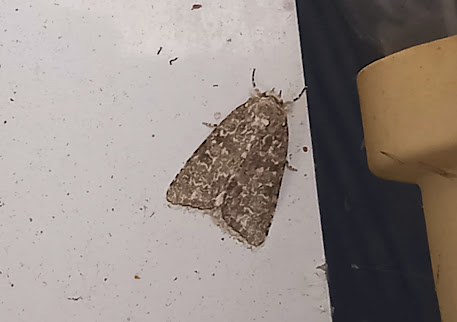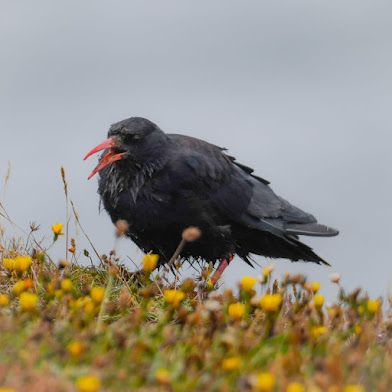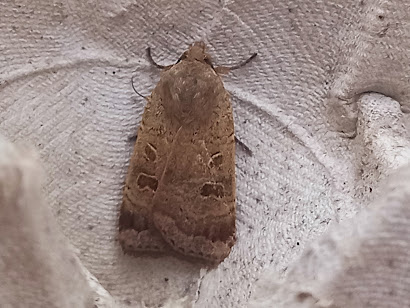Saturday 20th July 2024.
Only my second ever Dusky Sallow moth in my garden.
I really have this love / hate relationship with the so-called Weather guys who virtually second guess what the following day's weather is going to be like and after hearing that today was going to be another warm sunny day with the odd shower or two, then one would dress appropriately for the day. Nope, it was overcast virtually all day and just a glimmer of sunshine in the afternoon! Yes, it was warm, thankfully, as I was virtually in shorts and t-shirt for the day, though I took my fleece along with me. The day kicked off with the Moth Box for the third day running and yet again, it came up with some very nice moths and a reasonable number too.
Both new for the year, a Lesser Yellow Underwing (above) and Gold Triangle (below).
Finally, there was not only quality but also quantity this morning regarding my moth haul with a total of at least 87 moths of 42 species. Six more species were added to my year list with a welcome inclusion of only my second ever Dusky Sallow in my garden. A Canary-shouldered Thorn sat on the edge of the moth box but flew off before I could pot the moth, but two August Thorns were present and played ball with me. My first Lesser Yellow Underwing was present in one of the egg trays and regarding the micro moths, my first Common Masoners and a Willow Ermine of the year were present. Finally, my first Gold Triangle moth of the year was in the moth box. I could write chapter and verse about the many nice moths today, but there is so much more to write about; especially when Geoff Farwell and myself checked the other Moth Box at Andy’s garden.
The following moths were present this morning:
- Riband Wave 11
- Common Emerald
- Bright-line Brown-eye 2
- Brimstone Moth 2
- Lime-speck Pug 2
- August Thorn 2
- Canary-shouldered Thorn (New For Year)
- Large Yellow Underwing
- Lesser Yellow Underwing (NFY)
- Silver Y 3
- Heart & Dart
- Lackey 3
- Dusky Sallow (NFY)
- Willow Beauty 4
- Pale Mottled Willow
- Dark Arches
- Double-striped Pug 6
- Buff Ermine
- Common Rustic 3
- Small Ranunculus 2
- White Ermine
- L-album Wainscot
- Brown House Moth 2
- Rusty-dot Pearl
- Gold Triangle (NFY)
- Diamond-back Moth
- Beautiful Plume 2
- Garden Grey
- Elderberry Pearl
- Garden Grass-veneer 2
- Rosy Tabby
- Common Masoner (NFY) 3
- Black-banded Masoner 4
- Dotted Masoner
- White-shouldered House Moth
- Ruddy Streak
- Bird-cherry Ermine 4
- Willow Ermine (NFY)
- Common Plume 2
- Light Brown Apple Moth 3
- Four-spotted Yellowneck 2
- Italian Bark Moth
Arriving at Andy’s house around 8am, Geoff and I quickly got stuck into the many moths present here this morning. Yet again, his Moth Box was full of surprises with an additional three more moth species added to my year list which currently stands at 171 species for the year so far. A gorgeous Black Arches moth was resting in one of the egg trays and a Small Fan-footed Wave (my first for many a year) was on one of the window sills. Checking the egg trays thoroughly, I discovered my first Azalea Leaf Miner of the year in one of the egg trays and with a good supporting cast of Dark-bordered Pearl, September Thorn and Maiden’s Blush was present. Of the micros, both Meal Moth and Twenty-plume Moth were found just outside of Andy’s main garden. Just goes to show, you really need to really look hard to find the moths during the daytime.
Above, a Small Fan-footed Wave and below, Black Arches moth. Both new for the year.
The moths present here this morning included the following:
- Small Fan-footed Wave (NFY)
- Dark-bordered Pearl
- Riband Wave 5
- Uncertain
- September Thorn
- Buff Ermine
- Common Carpet
- Black Arches (NFY)
- Common Rustic
- Double-striped Pug
- Maiden’s Blush
- Large Yellow Underwing
- Brown House Moth
- Garden Grey 2
- Pied Grey
- Elderberry Pearl
- Meal Moth
- Twenty-plume Moth
- Azalea Leaf Miner (NFY)
- Rosy Tabby 3
- White-banded Grass-moth
- Garden Grass-veneer
- Blackthorn Knot-horn
Titchfield Haven, Hill Head:
Above, a pair of Avocets flying over Titchfield Haven and below, an adult Mediterranean Gull with its juvenile offspring flying out over the Solent.
There could have been a number of places we could have gone to today, but when a couple of Black Terns flashed up on the ‘Lazee’s Whatsapp’ seen this morning off Hill Head heading west; I thought why not have a look off Hill Head first thing. On arrival, the tide was up and a fresh southerly breeze came in off the Solent as we watched the Terns flying overhead either into the Solent or back onto the reserve. Common, Sandwich and a few Little Terns were seen and the occasional Med Gull would fly past, including several browner juveniles. I was sure I heard a Common Sandpiper and on close inspection of the mud fringed reedbed nearby, I found two birds in total, walking along the small area of mud by the reeds. Common Terns fished the water close by and a lone Black-tailed Godwit was seen further by the reed on the Meon.
Above, from Hill Head, we watched these Mediterranean Gulls flying over and below, also this Sandwich Tern over the Solent.
Above and below, Andy and Geoff check out the Common Sandpipers near the main road.
One of the Common Sandpipers in front of the reedbed.
Above, a pair of Common Terns flying over our heads and into the Solent.
On arrival here, I scanned the area thoroughly and I was sure I saw a Spoonbill flying low over the South Scrape in front of the Meonshore Hide. Later today, Birdguides confirmed that one was present on the reserve. Avocets could be seen on the South Scrape while a few flew over the reserve and showed well with the grey sky behind them. Looking north, I could see Swifts and a few Swallows hawking over the reedbeds and way in the distance, a Common Buzzard was soaring over the reserve. Though we checked the sea several times for anything of note, there were an awful lot of boats sailing out on the Solent and just a few distant Terns and Cormorants were all we saw. Finally, before we left, a Turnstone buzzed past us and flew out into the Solent.
Canal Path, Titchfield:
Above, a male Blue-tailed Damsefly and below, a Golden-ringed Dragonfly consuming a Common Wasp.
Above, a male Banded Demoiselle and below, a female of the same species.

Of course, with Geoff in tow, we had a lot of plants identified, which was most useful and although it was still overcast, we certainly had a nice variety of plants, insects and birds to enjoy. Sadly, there were a lot of dog-walkers present and many never bothered to pick up the dog mess and so you had to watch your step. The Canal Path is rather overgrown with plants that included Greater Willowherb that sported their pink flowers and intermingled among these were the likes of Giant Hogweed and Common Ragwort. Geoff pointed out an interesting plant called Upright Hedge Parsley and also Marsh Woundwort, which is a close relative of Hedge Woundwort. Meadowsweet was growing in a few places and I have found out that it is used a lot in medicines. Despite being overcast, there were quite a few butterflies on the wing that included Gatekeeper, Small and Large White, two Marbled White’s, Meadow Brown, Comma and Red Admiral. The wooded area certainly had the potential for Purple Hairstreaks, but none were seen today. A superb Golden-ringed Dragonfly was seen by the Bridge, tucking into a Common Wasp it had just caught (see photo) and nearby, both male and female Banded Demoiselle were seen with more seen further down the Canal Path. A Blue-tailed Damselfly was seen along the hedgerow further south along the Canal Path. From the Bridge, looking down in the crystal clear water, a school of Rudd fish swam through and some smaller fish that I have not got a clue what they were!

Above, the striking Four-banded Longhorn Beetle on a Bindweed flower. Below, a Gatekeeper butterfly.
Above, the plant Meadowsweet and below, the Upright Hedge Parsley.

Regarding the birds seen and heard, the footpath provided sightings of several Warbler species including a female Blackcap (by the Bridge), Chiffchaff, Common Whitethroat and Cetti’s Warbler. A Reed Warbler was heard singing still out in the fields within the reeds. A male Reed Bunting was seen singing out in the fields, while overhead, we saw a large mixed flock of House Martins and Swifts hawking insects. There were good numbers of both Grey Heron and Little Egret out in the fields and a Cattle Egret flying north was a bonus. A Grey Wagtail dropped in briefly by the Bridge, but promptly disappeared when we arrived at the Bridge. There were not many raptors seen today and surprisingly, no sightings whatsoever of any Marsh Harriers! But we did have a close view of a Common Buzzard sailing low overhead and the day was rounded off nicely with a Hobby flying east over the Canal Path. Another good days birding with these great guys.

Above and below, a Common Buzzard sailed low overhead when we took a rest on one of the benches.
Above, a female Blackcap was flitting about in the brambles by the Bridge. Below, the pink flowers of the Greater Willowherb.
Above, looking over the Bridge into the Canal, we saw a good number of Rudd swimming. Below, Geoff pointed out these Marsh Woundwort plants.










.jpg)
.jpg)





































